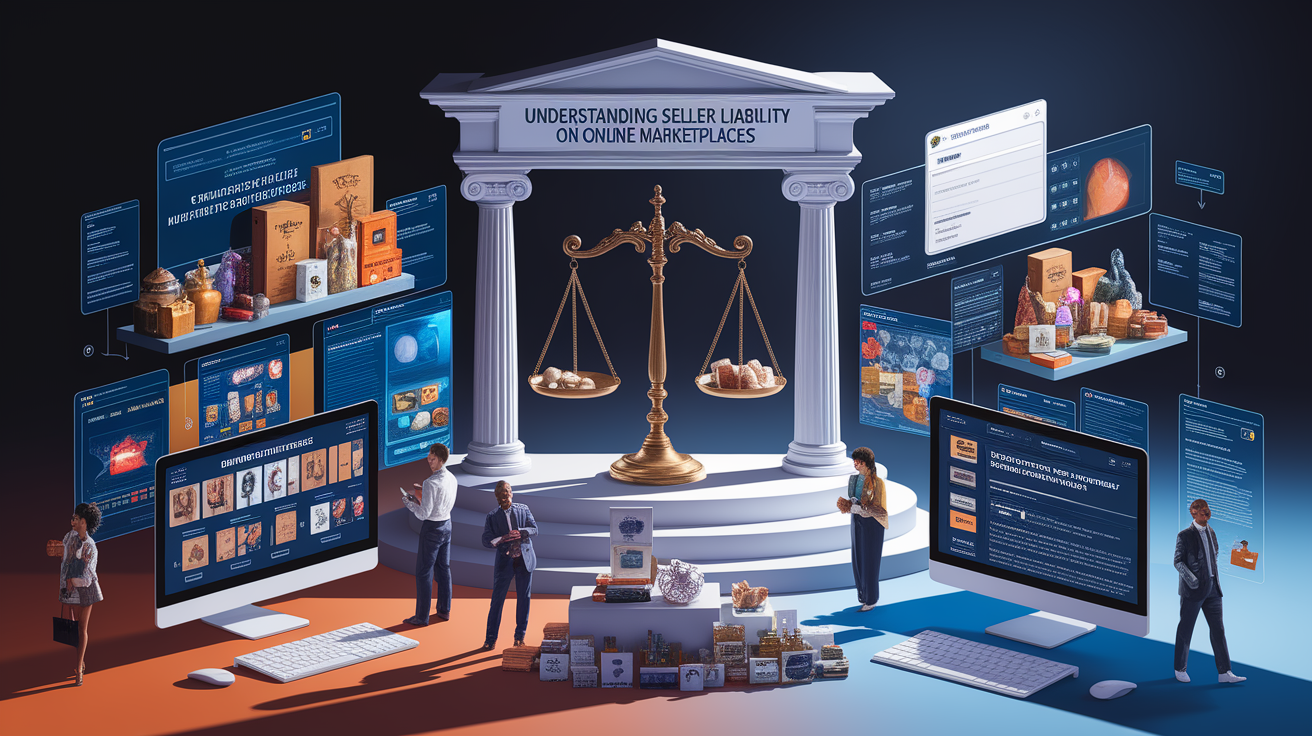Understanding Seller Liability on Online Marketplaces
Liability in the world of online marketplaces can feel like standing at the bottom of a mountain with no climbing gear — daunting, especially when you’re a seller trying to understand your legal responsibilities. In simple terms, “product liability” means you can be held responsible if an item you sell causes harm because it’s defective or unsafe, even if you didn’t manufacture it.

According to legal guides on e-commerce transactions, sellers who place goods into the “stream of commerce” are typically accountable for the safety of those products. Online marketplaces like Amazon, eBay, and Etsy often act as intermediaries, but they’re generally shielded from liability for third-party listings under Section 230 of the Communications Decency Act—although several states are shifting toward holding platforms accountable when they play an active role in sales and distribution (learn more about marketplace liability factors).
Why does this matter to you as a seller? Because failing to understand the legal framework could mean costly lawsuits, damaged reputation, and even losing your right to sell on certain platforms. But knowledge, like the right climbing gear, will help you ascend safely.
Implementing Robust Product Compliance Measures
Compliance isn’t just a box to tick — it’s the safety net that catches you before a fall. Product compliance involves meeting all relevant safety, labeling, and quality standards before listing your goods. It’s the legal equivalent of ensuring your foundation is solid before building a house.

To keep your business on the right side of consumer protection regulations, consider these proactive steps:
- Know Your Standards: Research national and state-level product safety regulations before listing any item (read how liability applies in e-commerce).
- Document Everything: Maintain records of supplier certifications, safety testing, and quality assurance checks.
- Vet Suppliers: Use marketplaces’ seller verification processes to ensure you work only with trustworthy vendors.
- Update Listings: If safety guidelines change, promptly modify your product descriptions and instructions.
Think of compliance as a fortress wall — it doesn’t prevent storms, but it shields you from the worst impacts.
Leveraging Consumer Protection Policies for Seller Advantage
Consumer protection policies aren’t just obligations — they can be competitive advantages. When buyers feel secure, they are more likely to purchase from you and return for future transactions. These policies act as bridges between you and consumer trust.

Key protections to understand and use to your benefit include:
- Refund Policies: Clear refund and warranty terms show transparency, reducing disputes and boosting confidence.
- Buyer Protection Programs: Many marketplace platforms offer these; participating can spotlight your credibility.
- Fraud Prevention: Robust procedures can protect both you and your customers from counterfeit goods and scams.
- Compliance With Consumer Laws: The INFORM Consumers Act outlines seller obligations to ensure transparency and accountability.
Would you prefer your buyers to feel cautious or confident? Strong consumer-friendly terms can make your shop the trusted choice in a crowded marketplace.
Practical Steps to Minimize Liability and Enhance Trust
Reducing liability and increasing buyer trust requires consistent action. It’s not a one-time fix — it’s an ongoing process, like regularly maintaining a well-traveled road.
- Secure Seller Insurance: Seller liability insurance covers claims for defective products and other risks.
- Proactive Communication: Respond promptly to complaints; a timely reply can prevent disputes from escalating.
- Implement Quality Control: Use checklists to verify product condition before shipment.
- Transparent Terms of Service: Clearly define your responsibilities and limitations to prevent misunderstandings.
- Engage with Marketplace Compliance Tools: Platforms often provide risk monitoring systems; use them fully.
By following these steps, you turn potential weak spots into fortified positions, making it harder for liability claims to pierce your defenses.
Benefits of Proactive Liability Management
When you manage liability proactively, you gain more than just legal safety — you gain peace of mind. Think of it as planting seeds of trust that grow into loyal customer relationships over time.
Consider the tangible advantages:
- Reduced Risk: Fewer claims mean less time, money, and stress spent on legal battles.
- Improved Buyer Confidence: Shoppers prefer sellers with proven safety and reliability records.
- Platform Recognition: Marketplaces often reward high-performing sellers with better visibility and promotional opportunities.
- Long-Term Savings: Avoiding penalties and disputes protects your profit margins.
Statistics show that sellers with clear compliance strategies and consumer protection measures experience up to 35% fewer refund claims compared to those without such systems. In the fast-moving world of e-commerce, that margin is the difference between thriving and merely surviving.
Ultimately, managing liability isn’t about fear of lawsuits. It’s about building a business that customers trust — and platforms value. By mastering these measures, you protect your livelihood and create a safer marketplace for everyone.







